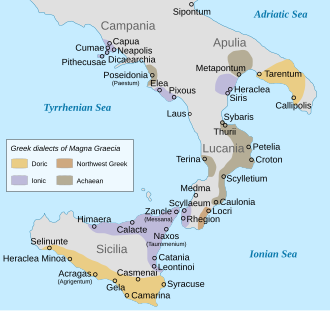
Back اليونانية الدورية Arabic Дорийски диалект Bulgarian ডোরিক আঞ্চলিক ভাষা Bengali/Bangla Grec dòric Catalan Dórština Czech Dorisches Griechisch German Δωρική διάλεκτος Greek Dora dialekto de la antikva greka lingvo Esperanto Griego dórico Spanish Doorilainen murre Finnish
This article needs additional citations for verification. (April 2021) |
| Doric Greek | ||||||
|---|---|---|---|---|---|---|
| Region | Acarnania, Aetolia, Epirus, western and eastern Locris, Phocis, Doris, Achaea, Elis, Messenia, Laconia, Argolid, Aegina, Corinth, Megara, Kythira, Milos, Thera, Crete, Karpathos, Rhodes, and possibly ancient Macedonia Also, colonies of the aforementioned regions in Cyrene, Magna Graecia, Black Sea, Ionian Sea and Adriatic Sea | |||||
| Era | c. 800 – c. 100 BC; evolved into the Tsakonian language | |||||
Indo-European
| ||||||
Early form | ||||||
| Dialects |
| |||||
| Greek alphabet | ||||||
| Language codes | ||||||
| ISO 639-3 | – | |||||
grc-dor | ||||||
| Glottolog | dori1248 | |||||
Distribution of Greek dialects in Greece in the classical period.[1]
Distribution of Greek dialects in Magna Graecia (Southern Italy and Sicily) in the classical period.
| ||||||
Doric or Dorian (Ancient Greek: Δωρισμός, romanized: Dōrismós), also known as West Greek, was a group of Ancient Greek dialects; its varieties are divided into the Doric proper and Northwest Doric subgroups. Doric was spoken in a vast area, including northern Greece (Acarnania, Aetolia, Epirus, western and eastern Locris, Phocis, Doris, and possibly ancient Macedonia), most of the Peloponnese (Achaea, Elis, Messenia, Laconia, Argolid, Aegina, Corinth, and Megara), the southern Aegean (Kythira, Milos, Thera, Crete, Karpathos, and Rhodes), as well as the colonies of some of those regions in Cyrene, Magna Graecia, the Black Sea, the Ionian Sea and the Adriatic Sea. It was also spoken in the Greek sanctuaries of Dodona, Delphi, and Olympia, as well as at the four Panhellenic festivals; the Isthmian, Nemean, Pythian, and Olympic Games.[2][3][4]
By Hellenistic times, under the Achaean League, an Achaean Doric koine appeared, exhibiting many peculiarities common to all Doric dialects, which delayed the spread of the Attic-based Koine Greek to the Peloponnese until the 2nd century BC.[5] The only living descendant of Doric is the Tsakonian language which is still spoken in Greece today;[6] though critically endangered, with only a few hundred – mostly elderly – fluent speakers left.[7]
It is widely accepted that Doric originated in the mountains of Epirus in northwestern Greece, the original seat of the Dorians. It expanded to all other regions during the Dorian invasion (c. 1150 BC) and the colonisations that followed. The presence of a Doric state (Doris) in central Greece, north of the Gulf of Corinth, led to the theory that Doric had originated in northwest Greece or maybe beyond in the Balkans. The dialect's distribution towards the north extends to the Megarian colony of Byzantium and the Corinthian colonies of Potidaea, Epidamnos, Apollonia and Ambracia; there, it further added words to what would become the Albanian language,[8][9] probably via traders from a now-extinct "Adriatic Illyrian" intermediary.[10] In the north, local epigraphical evidence includes the decrees of the Epirote League, the Pella curse tablet, three additional lesser known Macedonian inscriptions (all of them identifiable as Doric),[11] numerous inscriptions from a number of Greek colonies. Furthermore, there is an abundance of place names used to examine features of the northern Doric dialects. Southern dialects, in addition to numerous inscriptions, coins, and names, have also provided much more literary evidence through authors such as Alcman, Pindar, and Archimedes of Syracuse, among others, all of whom wrote in Doric. There are also ancient dictionaries that have survived; notably the one by Hesychius of Alexandria, whose work preserved many dialectal words from throughout the Greek-speaking world.
- ^ Roger D. Woodard (2008), "Greek dialects", in: The Ancient Languages of Europe, ed. R. D. Woodard, Cambridge: Cambridge University Press, p. 51.
- ^ Karali, Maria (2007). "The classification of the ancient Greek dialects". In Christidis, Anastassios-Fivos; Arapopoulou, Maria; Chriti, Maria (eds.). A History of Ancient Greek: From the Beginnings to Late Antiquity. Translated by Markham, Chris. Cambridge University Press. pp. 390–391. ISBN 978-0-521-83307-3.
- ^ Méndez Dosuna, Julián (2007). "The Doric dialects". In Christidis, Anastassios-Fivos; Arapopoulou, Maria; Chriti, Maria (eds.). A History of Ancient Greek: From the Beginnings to Late Antiquity. Cambridge University Press. pp. 444–445. ISBN 978-0-521-83307-3.
- ^ Striano, Araceli (2014). "Doric". In Giannakis, Georgios K.; Bubenik, Vit; Crespo, Emilio; Golston, Chris; Lianeri, Alexandra; Luraghi, Silvia; Matthaios, Stephanos (eds.). Encyclopedia of Ancient Greek Language and Linguistics. Vol. 1. Brill Publishers. pp. 515–516. ISBN 978-9004225978 – via Academia.edu.
- ^ Buck, Carl Darling (1900). "The Source of the So-Called Achaean-Doric κοινη". American Journal of Philology. 21 (2): 193–196. doi:10.2307/287905. JSTOR 287905.
- ^ "MultiTree: A Digital Library of Language Relationships — Tsakonian". Archived from the original on October 3, 2018.
- ^ Moseley, Christopher (2007). Encyclopedia of the world's endangered languages. New York: Routledge. s.v. "Tsakonian".
- ^ Çabej, E. (1961). "Die alteren Wohnsitze der Albaner auf der Balkanhalbinsel im Lichte der Sprache und der Ortsnamen". VII Congresso Internaz. Di Sciense Onomastiche: 241–251.; Albanian version BUShT 1962:1.219-227
- ^ Eric Hamp. Birnbaum, Henrik; Puhvel, Jaan (eds.). The position of Albanian, Ancient IE dialects, Proceedings of the Conference on IE linguistics held at the University of California, Los Angeles, April 25–27, 1963.
- ^ Huld, Martin E. (1986). "Accentual Stratification of Ancient Greek Loanwords in Albanian". Zeitschrift für vergleichende Sprachforschung. 99 (2): 245–253.
- ^ O'Neil, James. 26th Conference of the Australasian Society for Classical Studies, 2005.
© MMXXIII Rich X Search. We shall prevail. All rights reserved. Rich X Search

